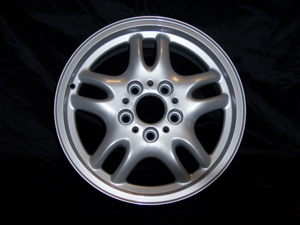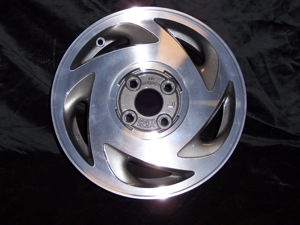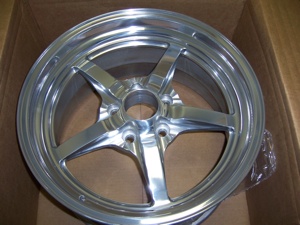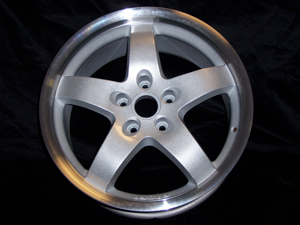
If you’ve spent more than a week in this business, you’ve probably been presented with some kind of problem related to wheel cosmetics. Whether it’s trying to identify and replace a wheel, figuring out how to repair cosmetic damage, or advising customers on how to care for their expensive chromies, knowing about wheel cosmetics will make your job easier just about every day.
So to help out, here’s a primer on wheels cosmetics, and some tips and tricks that will make your job and your customer’s lives easier when dealing with their wheels.
Basically, wheel cosmetics fall into two major categories: clear-coated and not clear-coated. Clear-coated finishes include just about all painted and polished wheels, which are covered with a clear protective sealant called “clear-coat” that prevents air and water from getting at the finish.
Non-clear-coated finishes include a few of the older hand-polished finishes as well as all chrome-plated wheels, which are not coated with any type of sealant and will need special treatment.
Paint and Machining
The vast majority of OE wheels out there are either painted or machine-polished. Silver-painted wheels, like the BMW wheel shown here, are often mistaken by customers and techs alike for a simple metal finish, when they are actually an automotive-style paint or a baked-on powdercoat. Additionally, a simple painted wheel can come in a dizzying variety of colors – in fact just about any color imaginable.
Machine-polished wheels, on the other hand, are a bare metal finish that have been polished by a CNC lathe before being clear-coated. These finishes will be much shinier than most paints, and will usually show a pattern of concentric lines in the metal, much like an old record album (ask your parents), left by the lathing process.

It’s important to know the difference if you have to try to repair or replace a damaged wheel. Many wheels nowadays will combine the two finishes as well, making for hybrid styles such as “flange-cut” with a painted center and a machined outer edge or “paint in the pockets” where the lower parts of the wheel are painted but the high parts of the spokes are machined.
Whichever combination is used, the care and feeding of any clear-coated wheel is pretty much the same. The first and most important rule is to be gentle with the clear-coat. Clean the wheels with gentle cleaners and avoid abrasives and acids like the plague.
One of the saddest things I’ve seen in this business was a father whose son had decided to surprise him on Father’s Day by washing his car, including diligently applying plenty of elbow grease to remove every bit of the baked-on brake dust in every nook and cranny of his father’s expensive wheels.
Unfortunately, he used steel wool; when it comes to wheels, steel wool is pure concentrated evil. While the wheels were still wet, the water itself concealed the millions of tiny scratches that the steel wool was leaving in the clear-coat, but once the wheels were dry the extent of the damage became heartbreakingly clear.
In addition, you and your customers need to be careful about what kind of cleaning products get used on clear-coated wheels. Many wheel cleaners out there should never actually be used on wheels because they are based on low-acid solutions. In general, if a wheel-
cleaning product instructs the user to spray the product on the wheel and remove it within 2-5 minutes, you’re dealing with an acid solution.
These kinds of cleaners actually work quite well at burning brake dust off the surface of wheels very quickly, which is one reason that they are often used by carwashes, but the problem is that over a few applications the acid will eat the clear-coat right off the wheel. As air and water seep in under the damaged clear-coat, a characteristic white spider web pattern of aluminum corrosion will show up on the wheel’s surface.

Polish
While many silver-painted wheels may look like bare metal, polished wheels are bare metal, polished to a near-mirror shine that falls somewhere between paint and chrome. While most newer polished wheels will now have a clear-coat, many older polished wheels may not, as it used to be very difficult to make clear-coat stick to the bare metal.
Even though most polished wheels should be treated like any other clear-coated wheels, there are still polished wheels – particularly classic “hot rod” wheels – that have no protection against the elements. These non-clear- coated wheels must be waxed, usually every week, to keep them from rusting, which is why such wheels are generally a labor of love for those insane enough to still use them.
Chrome
Chrome wheels are simply electroplated with a thin coating of metal and have no clear-coat. This gives a bright and shiny finish that is obviously a crowd favorite for the classic “bling” look.
But the finish is also extremely fragile and difficult to keep in good shape.
I always like to say that having chrome wheels is like dating a supermodel – beautiful, but high maintenance. Chrome-plated wheels have no clear-coat and should be maintained by polishing with household silver polish, the kind you can get in any hardware store that comes in a can of polish-impregnated batting. Tear off a bit of the batting and wipe the polish on the chrome, then buff off the polish with a clean dry cloth to get a good shine.
Because chrome is one thin layer of plating, any damage to the finish is not only nearly impossible to touch up, but the damage will also tend to flake further over time.
However, chrome’s worst enemy is salt. As it dries on the wheel, salt, especially salty water, will literally suck the metallic elements out of the chrome plating, causing the chrome to basically rot from within. This is why chrome-plated wheels should never be used during the winter in any areas that see snow and ice, because these are areas that use road salt and other chemical road treatments.
I always advise customers in the Northeast with chrome wheels to invest in a second set of wheels to put winter tires on. While it’s expensive in the short term, replacing chromies before their time is much more expensive.

I can still remember when the first PT Cruisers came out with optional chrome wheels that looked just fantastic on the sporty wagons.
Unfortunately, nobody warned the many proud new owners in the New England area why they should have another set of wheels for the winter. Within two years, I started seeing hundreds of PT Cruisers with formerly shiny wheels that seemed to have developed a severe skin rash, not to mention an equal number of extremely angry owners.
That’s about as good an example that can be offered as to why knowing about wheel cosmetics and passing on that information can save your customers a lot of grief and trouble, not to mention making you the hero of the story.
People who care about how their wheels need to know how to keep them looking that good. And, if you can help them out, they’ll not only keep coming back to you, but you can generally be sure that they’ll tell their friends. Be the hero.













